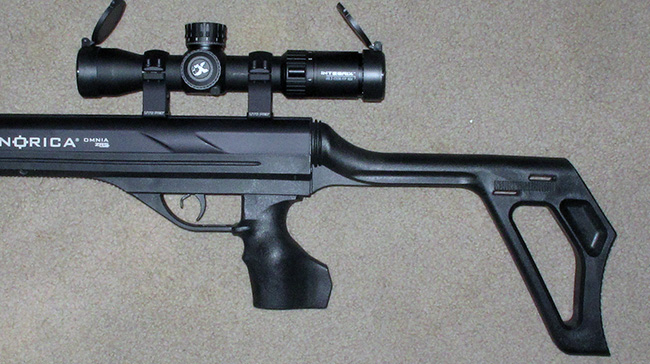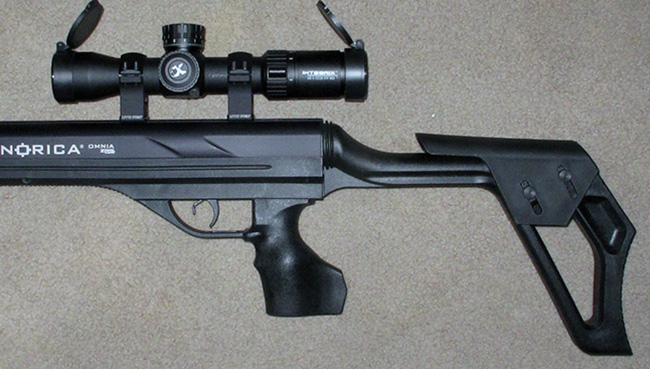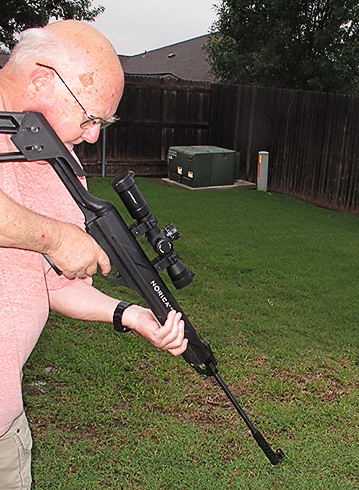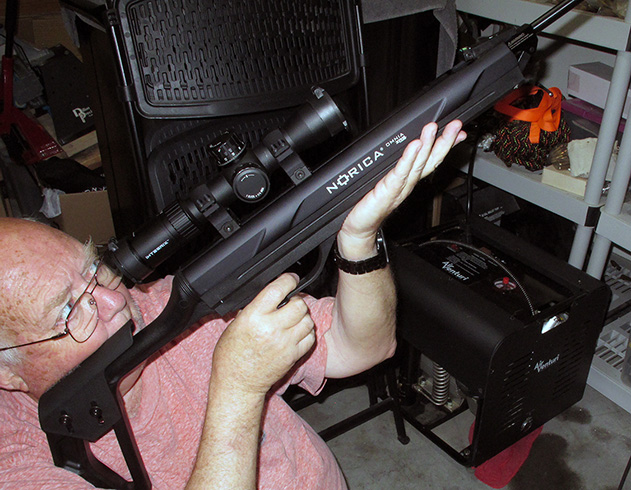Part 1
Part 2
Part 3
Integrix 2-12X36 FFP scope: Part 1
Part 4
Part 5
This report covers:
- Cheek weld
- Moving the scope
- Is the rifle still sighted in?
- The test
- Mistake
- First group
- Discussion 1
- No scope adjustment
- Second group
- Bottom line?
- Pointed down
- Pointed up
- Discussion 2
- Summary
Today will be special. Today we learn a LOT of things!
Cheek weld
Today is the test where I move the Integrix 2-12X36 scope forward on the Norica Omnia ZRS to see the full image through the eyepiece when the rifle is held comfortably. I will also install the cheek rest that I had to remove for the test with open sights. That will give me a good and repeatable cheek weld, which should give better accuracy. Let’s start there.
Moving the scope
I discovered in Part 5 that I was working too hard to position my face on the Omnia stock. It was the precision of the optics in the Integrix scope that clued me into that discovery. I was seeing a dark ring around the target, which was my eye being too close to the eyepiece of the scope. Just a half inch farther back and the image cleared up so the whole eyepiece was filled.
But there was more. My head was also sitting too low on the cheekpiece to see the image centered inside the dark ring. I had to move my head until the image was centered, more-or-less. I say that because the slightest movement shifted the image. So this drawback became a blessing because it forced me to always put my head in the same place. But doing that was hard because when the image was centered my cheek was only touching the stock lightly. So I resolved to move the scope forward and also to remount the cheekpiece that I had removed to see the open sights.

The Norica Omnia ZRS as it was set up for the last test.

The Norica Omnia ZRS after moving the scope and installing the cheekpiece for today’s test. Note that the cheekpiece is adjusted up a little and also slanted up in front.
As you can see the scope did move forward at least a half inch, or perhaps slightly more. I did this in four separate sessions, slowly creeping up on what seemed the correct distance. I’ll tell you why I said “seemed” in a bit.
I installed the cheekpiece and was surprised to discover that it had to be raised a little for me to see through the scope correctly. I also found that the cheekpiece can be tilted front and back to make it feel even better. Remember, this is the same cheekpiece I criticized for being too high (for me) when I shot with the open sights!
Is the rifle still sighted in?
Next point to consider. I have moved the scope forward about a half inch (12.7mm). Will I still be on target? I didn’t know. Theoretically (or like Hollywood does it) there is no problem. The 11mm scope grooves on the Omnia ZRS rifle tube should be level, which is a meaningless term when it comes to optics on guns. So — will I or won’t I? Only one way to tell. Do it.
I backed up to 25 yards and sighted on the center bullseye of a 5-bull 10-meter air rifle target. That gave me the most room to be off.
The test
I shot 10-shot groups from 25 yards today. The rifle was rested on a sandbag with the end of the forearm resting in the bag’s groove. I only shot two pellets today because the accuracy was just a part of what I was testing. And I read the Part 5 test to know which two pellets to select for today.
Mistake
But I made a mistake! I know, BB Pelletier doesn’t make mistakes, or if he does he camouflages them through Photoshop and weasel words. But I really did make a mistake today and I’ll tell you what it was, because it helps my story. But first — where did that first shot go?
The pellet was the JSB Exact Heavy and it was shooting one inch to the left and one inch below the aim point in Part 5. The first shot today hit the target about 3/4-inches to the left and 1-1/2-inches below the aim point, which was the center of the center bull. That’s close to the same place as before the scope was moved! I decided to shoot the next nine shots without adjusting the scope.

My first shot hit about where the 10-shot group would form. The scope moved on the rifle without disturbing the zero very much.
First group
In Part 5 the Omnia ZRS put 10 JSB Exact Heavy pellets into a group that measured 1.651-inches between centers. Let’s look at that group now.

This is the last test of this pellet with the scope not correctly mounted. Ten JSB Heavy pellets are in 1.651-inches between centers. The seven on the left are in 0.562-inches.
Today, with the scope in the right place for my eye, the Omnia put 10 of those same JSB Exact Heavy pellets into a 1.074-inch group. First — today’s group is smaller than the one shot in Part 5. Second, today’s group does contain a 7-shot subgroup that measures 0.617-inches between centers. That subgroup is larger than the 7-shot subgroup that was shot in Part 5.

Today with the scope easier to see the Omnia put ten JSB Exact Heavy pellets into a 1.094-inch group at 25 yards, with seven at the bottom in 0.617-inches. The bull I aimed at is above the dime.
It’s impossible to declare from just a single group (or in this case a single pair of groups) whether the Omnia was more accurate today or not. What I can say with certainty is it was easier to shoot today’s group than the group shot in Part 5. Moving the scope and adjusting the Omnia’s stock did that much for sure.
Discussion 1
Because I am shooting off a bench I’m holding the rifle differently that if I was shooting offhand. This is what I meant earlier when I said the scope seemed to be in the right place. The Integrix scope is so precise that even the angle of my head (coming down on the cheek rest instead of just alongside) made a small difference. It was easy to correct, but I wanted to make mention of it. If you use a really top-end scope like this one, I guess you have to learn it as well as your air rifle. I own four Meopta scopes and they are without a doubt premium optics, but what I’m experiencing for the first time is a truly top-end optic. I guess it just takes learnin’.
No scope adjustment
I decided not to adjust the scope after this group. If the rifle still shoots where it did in the Part 5 test the next pellet should be inside the bullseye.
Second group
For the second group I selected the JSB Exact RS dome. Because of my mistake mentioned earlier I failed to realize that this pellet and not the JSB Heavy was actually the one the Omnia likes. In Part 5 I shot two groups with this pellet. The first one measures 0.805-inches between centers and the second group measures 0.657-inches between centers. I think the second group was more representative and we’ll look at it now. Go back to Part 5 if you want to see to see why I say that.

In Part 5 the Omnia put 10 JSB Exact RS pellets into 0.657-inches at 25 yards.
Today with the Integrix scope positioned more correctly the Omnia put 10 JSB RS pellets into a group that measures 0.377-inches between centers. Please note that this group is extremely close to where the same pellet grouped in Part 5 before the scope was moved.

Today the Omnia rifle put 10 JSB Exact RS pellets into a 0.377-inch group at 25 yards.
Bottom line?
The four groups I am sharing from May 11 and today suggest that mounting the Integrix scope correctly may have had a small positive effect on the rifle’s accuracy at 25 yards. It certainly was much easier to shoot the groups today than it was back on May 11. So the lesson here is to work at mounting your scope until you can bring the rifle to your shoulder and look through the scope without having to move your head. And, we are not finished.
Reader Roamin Greco wondered if the rifle would still cancel recoil if it was pointed down or up. I tested that next.
Pointed down

The Norica Omnia ZRS rifle has no recoil when pointed down.
Pointed up

Pointed up the Norica Omnia ZRS rifle has no recoil.
The rifle is still without recoil when pointed up and down. How I tested it while pointing down is obvious. To test pointing it up I sat on my garage floor and pointed up at the cardboard box of rubber mulch.
Both pictures are posed. I took them and then took the shots. They are accurate representations of how I actually shot.
Discussion 2
The Norica Omnia ZRS breakbarrel rifle is unusual and unique. I have learned many things about it, and by extension, about the Integrix scope that was mounted on it. This will be my final test of this rifle.
The Integrix scope is a real performer. Please think of more tests I can do with it so I don’t have to return it soon!
Summary
I have tested the Norica Omnia ZRS rifle many times now and several things are apparent.
1. This rifle is extremely accurate, but it’s also pellet picky.
2. This rifle is absolutely recoil free.
3. The way it is designed it’s quite easy to mount a scope.
4. The trigger has a long and somewhat creepy stage two that mitigates against the accuracy.
5. The stock is designed for a scope and not for open sights.
6. The open sights do work well.
7. The Integrix scope is an optical marvel that does assist in accuracy by forcing repeatable head positioning.



B.B.,
OK, so we see that this rifle is meant to be scoped; and, once scoped, the cheekpiece becomes useful.
More important, the rifle is accurate and has no recoil…pretty cool!
As for being pellet picky, every airgun I have only gets used with one pellet, the one that’s best for that gun.
Hence, the only issue is the second stage of the trigger; yet you were still able to wring out good accuracy.
Looks like this rifle is a winner; thanks for this interesting set of reports. 🙂
Blessings to you,
dave
B.B.
So the stock now works with a scope? No custom stock needed?
My offer is still good….
-Y
Mattelomatic looks but obviously purpose built. As far as using it correctly, that is adjusting the cheek piece and using the pellets it likes, well that’s on the common sense of the operator. Besides that it has the power and the technology to use it accurately. Looking at the light pellets’ groups it seems there is really good potential.
I would get rid of the sights assembly though.
Tom,
Maybe this rifle ought to be pushed to 50 yards with JSB Exact RS to justify it being scoped especially with the Integrix? At 25 yards and under it is difficult to make a case of using the Integrix as a scope for a balanced package.
Siraniko
Siraniko,
I did give that some thought and I want to keep testing the Integrix for at least one more rifle, but I think I’ve come to the end of this rifle’s operating hours. 😉
BB
BB that is an expensive scope seems to have a small eye box not enough eye relief and so position sensitive. you would think a cheap scope would have those problems and I never had problems like that with cheap and mid range scopes
Siraniko,
This scope will never be a “balanced package” on any sproinger. This scope is almost twice the price of a walnut stocked TX200 MKIII. Most airgunners shooting that far will be using a PCP and/or a very high-powered scope so as to estimate the range more accurately on the field target range.
BB,
IMMHO, this is still a BUGLY looking air rifle. Being a trigger snob, that creepy thing would have to be worked on. I would have to get rid of those glowy thingys on there. For me, being “recoiless” is the only thing it has going for it.
The Integrix scope shows promise but is wasted on all but the finest of sproingers. It needs to be tried out on a real nice shooting PCP and stretch it out to 50 yards. I only have one air rifle “worthy” of such a scope, but it has a pretty nice scope on it right now, although I do like the power level as most all of my shooting is less than 100 yards.
Tom,
“The Integrix scope is a real performer. Please think of more tests I can do with it so I don’t have to return it soon!”
Well, you could try shooting the TX200 with it (using adapters), removing it, reinstalling it, and reporting on that. :^) Shootski has convincingly argued in detail why the test won’t work, but it seems to me the proof is in the pudding, not the reasons the recipe shouldn’t work. Besides, the results might be interesting regardless, and it is not as though this blog is a peer-reviewed scientific journal.
Michael
Michael,
See even more “convincing arguments” against asking B.B. to do even more work down a few Reply… especially stuff that might age him faster…Lol!
Also, have you received your RumbleRoller? I hope it works out really well for you.
shootski
shootski,
Yes, I have been using the RumbleRoller, and it is great! It has helped my hip pain and neurological issues in my right leg. My wife has found it helps ease her chronic upper back and shoulder pain as well.
Thanks again for that wonderful tip.
Michael
BB,
Just some comments on the Integrix scope . . .
The “precision” that you speak of on this scope (apart from the image quality itself) is function of two things – the eye relief, and the exit pupil. Eye relief is often spoken about on scopes, but exit pupil is a very important property that is often not even mentioned.
Exit pupil simply is the diameter of the zone of light that comes out of the scope in focus within the eye relief zone, and it is simple to know as it is the objective diameter divided by the power setting of the scope. Assuming that you were using this relatively low power scope at maximum power of 12, the exit pupil would be 36/12 which equals 3mm.
Our pupil diameter varies based on the amount of light hitting it, but generally when not in overly bright conditions they are in the 3-4mm diameter range (they get smaller in brighter conditions). One can see that if the exit pupil is only 3mm, and the pupil is about 3mm, then the eye is going to have to be in pretty much only one possible position to fully see them image (if off center, the image will be partial).
I think this is the “precision” that you were speaking to about this scope. Where it matters is that if one has a bigger objective scope, the exit pupil will be much larger, this will allow for more “slop” in terms of where the eye has to be located to see the full image. For example, if one were looking at a 8X image through a 56mm objective, the exit pupil would be 7mm, giving a 4mm area of variance that would allow a 3mm eye pupil diameter to see the full image.
With that in mind, what power were you testing it at, and what power do you typically shoot targets at with most scopes? This factor is important to understand when trying set up optics to be optimal, vs. just working well – I always determine scope ring height and fore/aft location with the scope on max power on my guns in order to get the lowest exit pupil diameter possible, in order to help set things up to have my eye be close to optimal even with not at max power.
There are probably some ideas along this line that could be tested out with this scope vs, other ones . . .
Alan
Alan,
At the 12X I was shooting the exit pupil is 3mm — larger than many other scopes.
BB
BB-
A suggestion for scope testing- (1)- two targets, two groups. One group at 2x and the other at 12x. One shot at 2x and then crank it up to 12x for shot two on the second bull. Repeat until you have two ten shot groups.
(2)- shoot ‘around the clock’ with strong side light (ie, late afternoon). Example- directly into and away from the setting Sun, and also left and right sides.
(3)- parallax test at two distances. One target at the 9 yard minimum and one at, say 25 yards. Repeat procedure as test one. One shot close and then next shot at distance, until you have two ten shot groups.
(4)- classic box test, one shot at a time until you have five ten shot groups. Time consuming, but it would seem this scope just begs for cranking the dials.
That’s all I have for now. You say you want to justify keeping the scope longer. I, and the rest of the gang, will keep thinking of ways to keep you busy. Perhaps more action shots of BB ‘modeling’?
Oh, and one more- using AlanMcD’s exit pupil size. At 2x, the largest available, shoot a group with head position at position extremes (up, down, left, right) for successive shots.
Paco,
Yeah, but I’m already 75.
Seriously, thanks.
BB
Got a chuckle. But I remember when I was 75. It was a very good year…
A comparison of group sizes shot at different powers would be interesting with this scope. I suspect they would be similar from 10 to 25 yards. Doing it with a very accurate rifle would help eliminate that variable.
You probably have another good year or so, plenty of time.
Tom,
As we get on in years, shooting air rifles such as the TX200 becomes ever more important. :^) No one in his later years bemoans sipping lemonade and plinking too much.
Michael
B.B. FYI, Yesterday’s blog no longer shows up for me. Is there an issue with it? I looked at the main web page showing the list of blogs in chronological order and it is missing from the list.
Roamin,
It’s there. I just was messing around during scheduling.
BB
Thank you.
B.B. and Readership,
I may have posted this Link before but it is one of the best explanations i have ever found: https://skyandtelescope.org/astronomy-equipment/a-pupil-primer/#:~:text=The%20exit%20pupil%20is%20a,image%20of%20the%20telescope's%20aperture.
This is probably the most important item:
“The problem is that if the exit pupil of a binocular or telescope is too large to fit into your eye, you lose some of the instrument’s incoming light.”
That one sentence tells you why YOU need to look through any scope you are thinking about buying…Tom can tell us all day about a scope and how “BRIGHT a particular scope looks to him; but it may not look that way to you!
shootski
PS: the “LOST” Blogs are back!
Shootski
Thanks for posting the Link. Good info and learning from this blog. I wonder what the author would say about exit pupil correlation with parallax.
“ For one thing, if the telescope’s exit pupil is exactly the size of your eye’s pupil, you must hold your eye rock-steady in exactly the right place or you’ll cut off light. This may be practical if you arrange to clamp your head in a vise. Otherwise, a margin of a millimeter or so gives comfortable room for slight natural movements.”
Unless something else is going on with my eyes I like a scope that forces me to have my eye in the same place for each shot as it minimizes parallax.
Deck
BB,
A test that has been put forth today by others is whether there is a zero change with a power change. On some scopes there can be a substantial change in POI (point of impact) when power is changed. This is normally an issue with cheaper scopes, though sometimes some “nice” scopes can do this also.
Is the Integrix guilty of such?
RR,
First of all, I ain’t sure that any scope is “guilty of such.” This calls for a great test!
BB
Yes, test it!
Deck
Hi Tom
That last grouping image with the dime with the caption “Today the Omnia rifle put 10 JSB Exact RS pellets into a 0.377-inch group at 25 yards.” is that accurate? because the groups looks closer to 0.7 inches rather than 0.377 inches (when compared against the dime on the right).